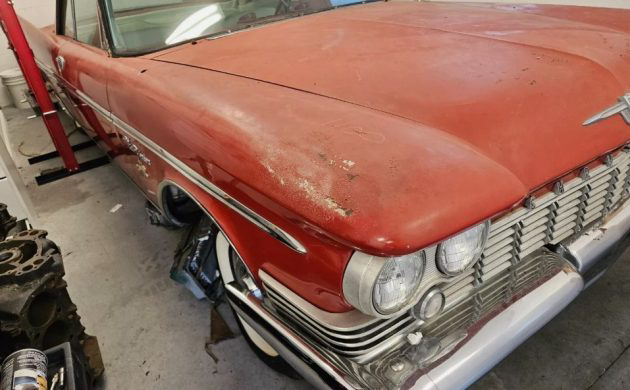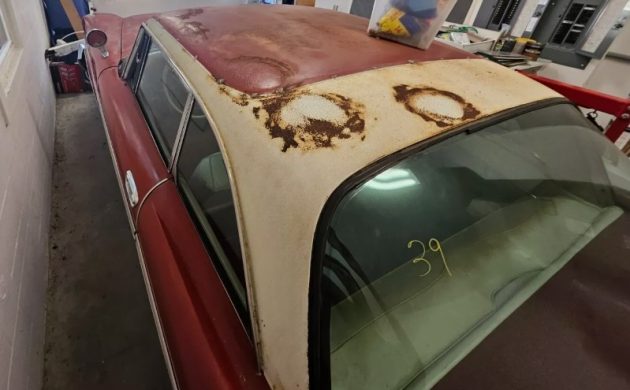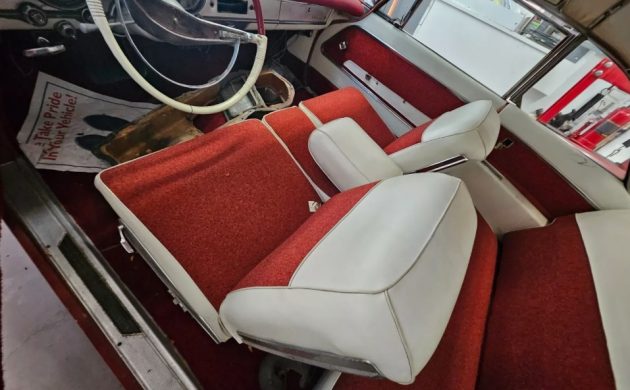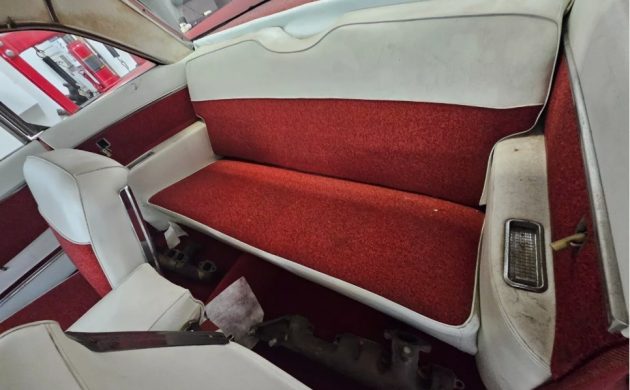When the Chrysler New Yorker retired in 1996, it was the longest-running U.S. nameplate at the time. It was Chrysler’s most prestigious product (excluding the Imperial often sold without Chrysler badging). The seller’s 1959 edition is from the company’s “Forward Look” era, so tailfins were growing at a rapid pace. It looks like a solid project car though its engine is in pieces and (hopefully) they’re all still there. Located in a tight garage in Orlando, Florida, this large Mopar is available here on eBay. The bidding is at just $1,025 while the seller says the reserve is low.
The New Yorker debuted in 1940 to help Chrysler better compete with the higher-priced automobiles sold by Mercury and parts of the General Motors family. To get a leg up on the rest of the industry, Chrysler borrowed a boatload of money for a major redesign of its cars resulting in a futuristic look that set the industry on its ear in 1957. Tailfins were “in,” and boxy bodies were “out.” That led GM to abandon its all-new 1958s to go in a similar direction for 1959. Unfortunately, the hot new Chryslers, Plymouths, Dodges, and DeSoto’s suffered from quality issues and rusted faster than the competition.
As the story goes, the seller purchased this New Yorker the way it is as a project that he/she has reconsidered. The body and interior look quite good with the surface rust on the roof perhaps due to something sitting on it for a whlle. Any trim not shown may be lurking in the trunk along with other car parts. So, from an appearance perspective, this Chrysler seems to have a lot going for it.
The 413 cubic inch “Golden Lion” V8 is said to be in pieces but none of the photos show any of it. Whether it needs more than a reassembly isn’t known. When the Chrysler was running, it should have been good for 350 hp paired with a push-button TorqueFlite automatic transmission (operating status unknown). At 82,500 miles on the odometer, this Mopar was one of just 2,434 2-door hardtops built in 1959 – making for a rare car today.








Take some decent pictures.
Definitely..it isn’t difficult. What’s so hard about pointing a cell phone camera and clicking a button? Unless you don’t want to show undesirable details which this car probably has a lot of.
Based on what we can see from the pictures on eBay, there might be something worth working on here, though there are a lot of details not shown. Hopefully a working drive train can be procured if the one with the car isn’t serviceable. It probably needs some electrical work too, based on what I see in the interior. These were nice cars and finding one that isn’t a rust bucket is extremely difficult.
Having a serviceable (if non-stock) interior is a big plus. The roof as well at the front fenders look like they are suffering from “tarp rash”. A worthwhile project, but it is my least favorite of the Forward Look Chryslers, ’59 being what to me is the most awkward “change for the sale of change” restyling of the original ’57’s. But then, I’ve been a long time owner of a ’57 NYer.
I love these, but that one’s a “million dollar project”, and not in a good way.
The only way to seriously consider a project like this is to see it in person and evaluate the missing parts status. I see numerous ‘unobtainium’ pieces missing. As for the interior being non-stock, I would source out SMS interiors or similar co. to locate the fabric. As for the 413 V8, don’t do it alone. Bring along someone familiar with these engines for help–maybe you a `59 Chrysler enthusiast in the Chrysler club? And get the car OUTSIDE in daylight to assess any rust issues! No room for that in the cramped garage. GLWTA!
Spot on Mr. Fox
The car is rare but does not make a restoration with parts missing and no information about the most important part, the engine.
350 horsepower- I don’t think so.
Yessir, 350 h.p. is precisely what the high compression 413 had with a 4-barrel carburetor. I know what I’m talking about. I have owned a 1963 New Yorker with the 413 for 33 years.
O.K., corrected.
The longest running U.S. nameplate in 1996 would have been the Chevrolet Suburban since 1935.